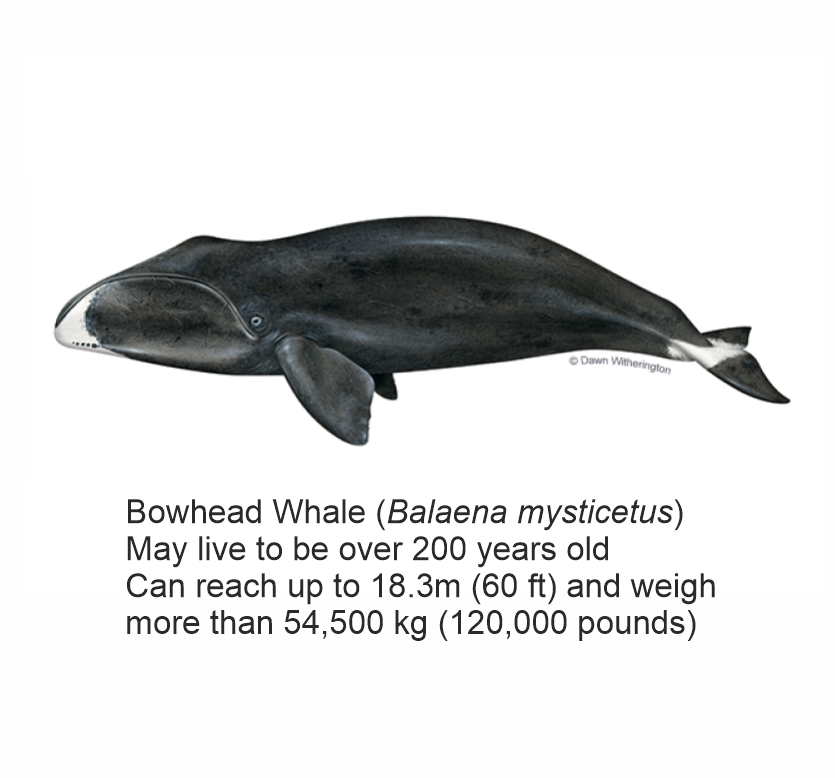A recent study reveals that bowhead whales, remarkable creatures inhabiting the Arctic, possess a highly specialized DNA protection mechanism that enables them to evade cancer and achieve exceptional longevity.
Researchers, including those from the University of Rochester in New York, have discovered that these whales, which can live for over two centuries, possess an extraordinary ability to repair damaged DNA, thus slowing down their aging process.
While previous studies have identified biological mechanisms in elephants that protect against cancer, the unique biological process found in bowhead whales sets them apart, as highlighted by the scientists involved in the study. The researchers emphasize that studying a mammal capable of maintaining its health and evading cancer for such an extended period offers valuable insights into a comprehensive evolutionary experiment, revealing numerous mechanisms influencing cancer and aging—an experiment far beyond the reach of human capabilities.
Despite being one of the largest creatures on Earth, with a weight exceeding 80 tons and a vast number of cells, the bowhead whale does not suffer from cancer—a peculiar phenomenon known as Peto's Paradox, puzzling scientists. This paradox suggests that despite having more cells than humans and living longer, large and long-lived animals like elephants and bowhead whales do not experience a proportionate increase in cancer incidence.
The researchers, in a preprint posted on the bioRxiv server, found that bowhead whales possess unique biological mechanisms that efficiently and accurately repair breaks in their DNA strands, surpassing other mammals in their repair capabilities. Additionally, they observed elevated levels of two proteins—CIRBP and RPA2—in bowhead whales. These proteins are known to enhance DNA repair efficiency in human cells.
The study's findings indicate that bowhead whales have evolved an accurate and efficient DNA repair process that safeguards the integrity of their genome, thereby contributing to their long lifespan free from cancer. Scientists suspect that the elevated expression of the CIRBP protein in the whale is a result of the unique physiological stresses endured in the Arctic, such as ultracold temperatures.
In drawing comparisons, the scientists liken this mechanism to whole-body cryotherapy, a technique widely employed in sports medicine to reduce inflammation and facilitate post-exercise or injury recovery. While the molecular mechanisms responsible for the benefits of cryotherapy remain largely unknown, the researchers speculate that increased CIRBP expression may contribute to health advantages by facilitating DNA repair.
Based on these new findings, researchers also speculate that locally delivering variants of the CIRBP protein could hold promise as a strategy to enhance tissue recovery following surgery or organ transplantation. However, it is important to note that currently, there are no approved therapies targeting DNA repair for the prevention of cancer or age-related decline.
Bowhead Whale
Bowhead whales are a unique species of whales that primarily inhabit Arctic and subarctic waters characterized by seasonal sea ice coverage. They are known to reside within a specific range of approximately 60° to 75° north latitude. Among all large whale species, the bowhead whale possesses the most remarkable adaptations to thrive in icy waters. Notably, they have developed a specialized adaptation in the form of a thick layer of blubber, which can reach a thickness of up to 1.6 feet. This insulating layer provides them with the necessary protection and insulation to navigate and survive in their frigid environment.
The bowhead whale, scientifically known as Balaena mysticetus, belongs to the baleen whale family Balaenidae and stands as the sole living member of the Balaena genus. This magnificent creature is uniquely adapted to the Arctic and subarctic waters, making it the only baleen whale endemic to these regions. It derives its name from the distinctive massive triangular skull it possesses, which enables it to break through Arctic ice. Other names commonly associated with this species include the Greenland right whale, Arctic whale, steeple-top, and polar whale.
Bowhead whales boast the largest mouth among all animals, comprising nearly one-third of their body length. They possess the longest baleen plates, measuring up to an impressive maximum length of 4 meters (13 feet). Additionally, these remarkable creatures are renowned for their exceptionally long lifespan, with individuals capable of living for over 200 years.
Unfortunately, bowhead whales were heavily targeted by early whaling efforts, leading to a significant decline in their population. In response, a moratorium was established in 1966 to protect these majestic creatures. Presently, the International Union for Conservation of Nature (IUCN) Red List categorizes three out of the five bowhead populations as "endangered," one as "vulnerable," and one as "lower risk, conservation dependent." However, the global population of bowhead whales is currently assessed as being of least concern.
Source:Independent, Wikipedia
Drawing of Whale:NOAA Fisheries (Dawn Witherington)

